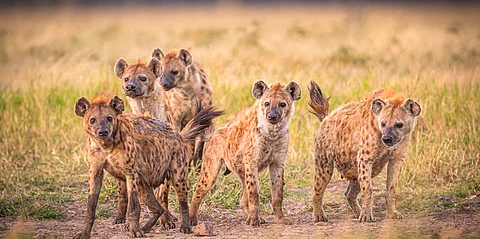

Climate change continues to amaze. In a new study, Egyptian researchers have discovered a spotted hyena (Crocutta crocutta), one of Africa’s most abundant carnivores, appeared in southern Egypt after 5,000 years. The researchers suspect increased precipitation may have brought the animal to the area.
“In February 2024, a spotted hyena killed two goats belonging to local people in Wadi Yahmib over a two-day period, within Elba Protected Area, 30 km north of the Sudanese and Egyptian border. The goat depredations occurred at night. The local people are master trackers and familiar with all large mammals of the area. The hyena was tracked by local people, located, chased, and intentionally hit by a pickup truck on February 24, 2024,” the researchers wrote.
The carcass was photographed and left for scavengers to consume.
The spotted hyena became extinct in Egypt 5,000 years ago.
“The species has not been recorded in contemporary Egypt, since becoming extinct over 5,000 years ago. However, Hofer and Mills (1998), mentioned unconfirmed records from Egypt through questionnaire surveys. The nearest stable population is in Sudan, with populations in north and south Darfur, north Kurdufan, and Dinder national park,” the authors added.
The area where the spotted hyena appeared and was killed is unique in Egypt. “This area is considered a continuation of the Sudanese tropical region and is the most floristically diverse part of Egypt,” according to the paper.
The region consists of an arid climate, with hot, rainless summers and mild winters. Precipitation falls mostly in the autumn and winter months but is not an annual event.
“The mountains bordering the Red Sea coast trap moisture as the clouds rise and condense, which results in higher precipitation and occasional flashfloods. The modest levels of seasonal precipitation (annual average for the years between 1983 and 2022 is 18 mm ± SE 0.155) transforms these arid plains into temporary meadows which are intensively utilized by local pastoralists,” read the paper.
So, what could have attracted the hyena into Egypt, 500 kilometres north of its range? The scientists count climate change and the civil war in Sudan as possible reasons.
They analysed precipitation in the region in the past two-and-a-half decades. They found that precipitation (and subsequently the amount of vegetation growth) has been higher during the past five years (2019-2022) when compared to the previous two decades.
There have been multi-year droughts and shorter ‘wet’ periods.
“This five-year period of less severe environmental conditions in the corridor area could facilitate the dispersal of a spotted hyena northwards into the south-eastern Egypt,” the experts wrote.
How so? Spotted hyenas can live on human food waste, livestock carcasses and occasional livestock depredation.
Native ungulates occur in the area, but their numbers are considered too low to support a population of large predators due to environmental and human disturbance.
The increased precipitation and vegetation may have resulted in a change of pastoral grazing practices. Locals now prefer to allow their livestock to graze freely (free-range grazing) instead of keeping them in a confined area with supplementary food, even transporting camel herds from Nile valley to the area for free pasture.
“In addition, the spotted hyena observation occurred in the winter, which is the season with the least environmental severity,” the paper noted.
The civil war in Sudan could be a reason too, according to the researchers, for the dispersal of the hyena into Egypt.
“The current political instability and civil war in Sudan could contribute to increased spotted hyena populations or distribution as hyenas engage in anthropophagy and will depredate weakened or vulnerable humans, especially during times of human crisis,” added the paper.
However, the researchers added that they did not believe spotted hyenas would become established in the area despite favourable environmental conditions or food availability. Human persecution (as in the present case) and human-wildlife conflict would prevent that.
“Our record supports the need of the spotted hyena’s IUCN Red List assessment to be continuously reviewed to account for the species ability to disperse and expand its range as a result of changing climatic conditions or unstable political situations,” the experts urged.
First record of the spotted hyena Crocuta crocuta in Egypt during the past 5,000 years has been published in the journal Mammalia. The authors are Abdullah Nagy, Said El-Kholy, Alaaeldin Soultan and Omar Attum.